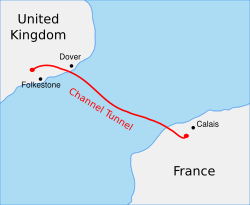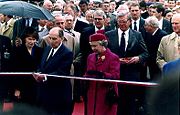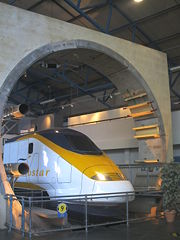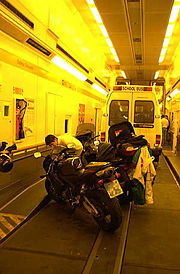Channel Tunnel
2008/9 Schools Wikipedia Selection. Related subjects: Engineering
| Channel Tunnel Le tunnel sous la Manche |
|
 |
|
| Map of the Channel Tunnel | |
| Info | |
|---|---|
| Location | Beneath the English Channel ( Strait of Dover) |
| Status | Active |
| Start | Folkestone, Kent, England |
| End | Coquelles, Pas-de-Calais, France |
| Operation | |
| Opened | 6 May 1994 |
| Owner | Eurotunnel |
| Operator(s) | Shuttle, Eurostar, EWS, SNCF |
| Technical | |
| Electrified | Yes |
The Channel Tunnel (French: le tunnel sous la Manche), also known as Chunnel or Eurotunnel is a 50.450 km (31.35 mi) long rail tunnel beneath the English Channel at the Strait of Dover, connecting Folkestone, Kent in England () to Coquelles near Calais in northern France (). The "tunnel" consists of three separate tunnels; two 7.6m diameter single track, single direction rail tunnels which are 30m apart and one 4.8m diameter service tunnel between them.
It was a megaproject with several false starts, but it was finally completed in 1994. It is the second-longest rail tunnel in the world, with the Seikan Tunnel in Japan being longer, but the undersea section of the Channel Tunnel, at 37.9 km (23.55 mi), is the longest undersea tunnel in the world. The American Society of Civil Engineers has declared the tunnel to be one of the Seven Wonders of the Modern World.
Historical proposals for, and attempts to start, a tunnel
A link between Great Britain and mainland Europe had been proposed on many occasions.
- 1802 Albert Mathieu-Favier, a French engineer, put forward a proposal for a tunnel. Passengers would travel through the tunnel in horse-drawn coaches, the road would be lit by oil lamps and a mid-tunnel junction at the Varne Bank would have provided a fresh-air respite for the horses. The cost was estimated at one million pounds.
- 1857 Aimé Thomé de Gamond presented an elaborate study to Napoleon III, Emperor of the French, proposing a rail tunnel from Dover to Cap Gris Nez via a mid-channel port/airshaft on the Varne sandbank. The cost was calculated at 170 million francs, or rather less than 7 million pounds sterling.
- 1865 George Ward Hunt proposed the idea of a tunnel to the Chancellor of the Exchequer, William Ewart Gladstone.
- 1868 Lord Granville declared the support of the British Government for the proposed tunnel.
- 1875 Peter William Barlow, who had worked extensively on the world's first underground railway, suggested a floating steel tube across the Channel. The idea was rejected.
- French & British Parliamentary bills passed to build the tunnel. Insufficient funds were raised and the concession ran out a year later.
- 1876 Extensive geological survey carried out; French sink two shafts.
- 1880 The South Eastern Railway (SER) arranges trial borings on the British side.
- 1881 Patented (Beaumont) boring machine drives a tunnel 820 m (897 yards) parallel to cliffs on the British side.
- Work begins by SER on Channel Tunnel; again insufficient funds. Submarine Continental Railway Company set up.
- 1882 Rival Channel Tunnel Company causes a rift in proceedings; adverse comments by media and an influential group (including Robert Browning and Alfred Lord Tennyson). Eventually work was halted by the Board of Trade because of military objections: the ease with which invaders could attack from the Continent was cited.
- 1922 Workers started boring a tunnel from below the chalk cliffs between Folkestone and Dover: after 128 m (400 ft) of tunnel had been completed, political objections again brought the project to an end.
After World War II the concept of the tunnel began to receive serious attention.
- 1955 Britain ceases its opposition to a Channel Tunnel on military grounds.
- 1974-1975 Following Britain's entry into the Common Market, another attempt was made to construct a tunnel by the British and French governments. Trial borings were made on both sides. However, a financial crisis meant that the British Prime Minister Harold Wilson cancelled the project as an economy measure.
The work of the Channel
Planning
In 1957 the Tunnel sous la Manche Study Group was formed. It reported in 1960 and recommended two main railway tunnels and a smaller service tunnel. The project was launched in 1973 but folded due to financial problems in 1975 after the construction of a 250 m (820 ft) test tunnel. According to Secretary of State for the Environment Anthony Crosland the immediate reason was that the two Channel Tunnel companies had given notice of abandonment to the Government because of excessive cost.
In 1984 the idea was relaunched with a joint British and French government request for proposals to build a privately-funded link. There were four proposals: two rail tunnels, a road tunnel and a bridge. Of the four submissions received, the one most closely resembling the 1973 plan was chosen, and announced on 20 January 1986. The Franco-British Channel Fixed Link Treaty was signed by the two governments in Canterbury, Kent on 12 February 1986 and ratified in 1987.
The planned route of the tunnel took it from Calais to Folkestone (a route longer than the shortest possible crossing) and the tunnel follows a single chalk stratum, which meant the tunnel was deeper than the previous attempt. For much of its route the tunnel is nearly 40 m (130 ft) under the sea floor, with the southern section being deeper than the northern.
Construction
Digging the tunnel took 13,000 workers over seven years, with tunnelling operations conducted simultaneously from both ends. The prime contractor for the construction was the Anglo-French TransManche Link (TML), a consortium of ten construction companies and five banks of the two countries. Engineers used large tunnel boring machines (TBMs).
In all, eleven TBMs were used on the Channel tunnel:
- three French TBMs driving from Sangatte to under the Channel,
- one French TBM driving the service tunnel from Sangatte cofferdam to the French portal,
- one French TBM driving one running tunnel from Sangatte cofferdam to the French portal, then the other running tunnel from the French portal back to Sangatte cofferdam,
- three British TBMs driving from Shakespeare Cliff to the British portal,
- three British TBMs driving from Shakespeare Cliff to under the Channel.
Completion

The British and French efforts, which had been guided by laser surveying methods, met first with the completion of the undersea service (access) tunnel. A small pilot hole broke through without ceremony on 30 October 1990. The difference in the centrelines of the two ends of the tunnel was surveyed as just 358 mm (14.1 inches) horizontally and 58 mm (2.3 inches) vertically. On December 1, 1990 the service tunnels broke through at the halfway point. TML carefully staged the break through for maximum effect: TML tunnellers Phillipe Cozette and Graham Fagg cut a heading between the two drives under the watchful eye of the media. With this event it became possible to walk on dry land from Great Britain to continental Europe for the first time since the end of the last ice age 8,500 years ago.
The main rail tunnels met on May 22, 1991 and on June 28, 1991, each accompanied by a breakthrough ceremony. When each pair of TBMs met, the French TBM was dismantled while the British one was diverted into the rock, concreted in place, and abandoned. The next few years were spent refining, equipping, and finishing the tunnels. In 1994 the Channel Tunnel was considered completed. The tunnel was officially opened by Queen Elizabeth II and French President François Mitterrand in a ceremony held in Calais on 6 May 1994. The Queen travelled through the tunnel to Calais on a Eurostar train which stopped nose to nose with the train which carried President Mitterrand from Paris. Following the ceremony President Mitterrand and the Queen travelled on Le Shuttle to a similar ceremony in Folkestone.
In the end, almost 4 million m³ (5 million cubic yards) of chalk were excavated on the British side, much of which was dumped below Shakespeare Cliff near Folkestone to reclaim 0.36 km² (90 acres) of land from the sea. Called Samphire Hoe, the area is now a popular park. In all, 8 million m³ (10.5 million cubic yards) of soil were removed, at an average rate of 2,400 tonnes per hour.
Ten workers were killed during the construction of the tunnel.
Description
The tunnel consists of three parallel tunnels running between the respective portals, or tunnel entrances, at either end. There are two rail tunnels, measuring 7.6 m (25 ft) in diameter and about 30 m (98 ft) apart, which carry trains north-west and south-east. Between the rail tunnels is a service tunnel, 4.8 m (16 ft) in diameter, which is connected by cross-passages to the main tunnels at intervals of approximately 375 m (1,230 ft). The service tunnel, served by narrow rubber-tyred vehicles, gives maintenance workers access to the rail tunnels and provides a route for escape during emergencies.
The two running tunnels are directly linked every 250 m (820 ft) by 2 m diameter pressure relief ducts (PRDs) that pass over the top of the service tunnel and do not connect to it. The PRDs alleviate the piston effect of trains by allowing airflow from moving trains to pass into the other running tunnel. Additionally, there are two enormous caverns situated about one third of the distance from shore to shore containing a rail crossover between the main tunnels. These crossovers permit sections of the tunnel to be closed to traffic for maintenance, using single-line working in the other tunnel. The UK crossover at 156 m long, 18 m wide and 10 m high is the largest subsea cavern in the world and, when being constructed, required extensive monitoring via almost 200 separate instrument stations.
At each portal there is a major facility allowing for trains to disassemble and turn around, including customs, maintenance, and other necessary services.
Statistics
The Channel Tunnel is 50.450 km (31.35 miles) long, of which 37.9 km (23.55 miles) are undersea. The average depth is 45.7 m (150 ft) underneath the seabed, and the deepest is 60 m (197 ft). It opened for business in late 1994, offering three principal services: a shuttle for vehicles, Eurostar passenger service linking London primarily with Paris and Brussels, and freight trains.
In 2005, 8.2 million passengers travelled through the tunnel on Eurostar while in the same year Eurotunnel carried 2,047,166 cars, 1,308,786 trucks and 77,267 coaches on its shuttle trains. Rail freight carried through the Channel Tunnel in 2005 was 1.6 million tonnes.
Passenger travel through the Channel Tunnel increased by 15% in 2004 and 2.4% in 2005 up to 7.45 million. Travel is expected to continue to increase with the opening of High Speed 1 to London.
A journey through the tunnel lasts about 20 minutes; from start to end, a shuttle train journey totals about 35 minutes, including travelling a large loop to turn the train around. Eurostar trains travel considerably slower than their top speed while going through the tunnel (approximately 160 km/h [100 mph]), rather than their maximum of 300 km/h (186 mph) to fit in with the shuttle trains and avoid problems with heat generated in the tunnels by friction.
At completion, it was estimated that the whole project cost around £10 billion, representing a cost overrun of 80%. The tunnel has been operating at a significant loss, and shares of the stock that funded the project lost 90% of their value between 1989 and 1998. The company announced a loss of £1.33 billion in 2003 and £570 million in 2004, and has been in constant negotiations with its creditors. Eurotunnel cites a lack of use of the infrastructure, an inability to attract business because of high access charges, too much debt which causes a heavy interest payment burden, and a low volume of both passenger and freight traffic 38% and 24%, respectively, of that which was forecast.
Location
| Point | Coordinates (links to map & photo sources) |
|---|---|
| British portal | |
| Mid-point | |
| French portal |
Operation
The tunnel is operated by Eurotunnel (Eurotunnel plc in the UK, and Eurotunnel SA in France).
Four types of train services operate:
- Eurostar high speed passenger trains. As of 17th November 2007 these connect London's St Pancras station with the Gare du Nord station in Paris and Brussels Midi/Zuid Station, some with stops at Ashford, Calais-Fréthun and Lille-Europe. There also are less frequent and/or seasonal services to other destinations, e.g. Avignon, Disneyland Paris and the French Alps.
- Eurotunnel Shuttle passenger shuttle trains. These carry cars, coaches and vans between Sangatte (Calais/Coquelles) and Folkestone. Enclosed rail wagons, some double-deck, with minor amenities permit drive-on and drive-off operation; passengers stay with their vehicles. Formerly marketed as Le Shuttle.
- Eurotunnel freight shuttle trains. These carry lorries on open rail wagons, with the lorry drivers travelling in a separate passenger coach.
- Freight trains. These trains carry conventional rail freight or container loads between Europe and Great Britain. They are operated jointly by EWS of the UK, and French national operator SNCF
Eurostar trains travel over land at high speeds on modern tracks designed for 300 km/h (186 mph), and within the tunnel at up to 160 km/h (100 mph). The first section of High Speed 1, between the tunnel and Ebbsfleet International railway station in North Kent, opened in 2003. Until the second section between Ebbsfleet and St Pancras opened in 2007 Eurostar trains used 'traditional' lines for the final part of the journey into Waterloo, running at much lower speeds.
There have been proposals for local passenger rail services linking Kent with towns in the Pas de Calais, similar to the local trains that run between the north and south islands of Zealand, but such a service remains unlikely.
In September 2006, EWS announced that due to cessation of UK-French government subsidies of £52 million per annum to cover the Channel Tunnel "Minimum User Charge" (a subsidy of around £13,000 per train, at a traffic level of 4,000 trains per annum), that freight trains post 30 November would presently stop running. EWS commented that the equivalent charge from the same distance from UK Network Rail would be £300, but that at current traffic levels the charge was effectively £8,000 per train. Accepting that the Channel Tunnel was a special case, and in light of UK Department of Industry intransigence, EWS said that they could not economically justify running trains to their customers in light of the higher charges. EWS commented that they believed that the UK Government's position was in part being defined by the current economic state and future of the Channel Tunnel operator, and its negotiations on refinancing its debt.
Fire
The Channel Tunnel's only serious operational incident was a fire on 18 November 1996 aboard a shuttle train carrying trucks and trailers. No lives were lost, due in large part to the safety of the tunnel design and the response of safety crews from France and the UK. The tunnel suffered £200 million of major structural damage over about a kilometre of length, and its safety procedures and emergency services liaison were substantially revised afterwards.
A less severe incident occurred on 21 August 2006, when a lorry aboard a shuttle train caught fire. Crews and drivers were evacuated and the fire was quickly extinguished. Service interruptions occurred as the train and tunnel were inspected for damage.
Sovereignty
As one of the first international undersea rail tunnels, the Channel Tunnel required an inventive approach to border controls, with the UK not being a member of the Schengen Agreement free-travel zone. The official border between France and the United Kingdom is marked by a stainless steel band, roughly halfway through the tunnel (the UK side is somewhat longer, because a longer part of the tunnel is under land). The British half is part of the District of Dover and the English county of Kent. As a practical matter border controls are handled at boarding or on the train. A detailed three-way treaty between the United Kingdom, France, and Belgium governs border controls, with the establishment of control zones wherein the officers of the other nation may exercise limited customs and law enforcement powers. For most purposes these are at either end of the tunnel; for certain city-to-city trains the train itself represents a control zone.
In the event of a serious incident relating to the tunnel, the emergency personnel dealing with the problem may declare that Emergency Plan "BINAT" (bi-national plan) is in force during which they have unrestricted access to all parts of the tunnel irrespective of sovereignty. Thus both UK and French emergency personnel may co-operate to deal with serious incidents. "BINAT" is also the term used for the regular emergency exercises conducted by UK and French forces.
In an unusual move, the British and French governments agreed to provide immigration staff at opposite ends of the tunnel; thus the French immigration control posts are located in the United Kingdom, while the British ones are in France. This leads occasionally to unusual incidents, for example when a French police officer wandered into the non-international part of Waterloo station while carrying a firearm. In the 1990s, the French authorities tried to arrest a French national working in the British terminal at Folkestone who had been evading French military service.
Asylum and Immigration
Illegal immigrants and would-be asylum seekers have been known to use the tunnel to attempt to enter Britain. By 1997, the problem had already attracted international press attention, and the French Red Cross opened a refugee centre at Sangatte in 1999, using a warehouse once used for tunnel construction; by 2002 it housed up to 1500 persons at a time, most of them trying to get to the UK. At one point, large numbers came from Afghanistan, Iraq and Iran, but African and Eastern European countries are also represented. Most migrants who got into Britain found some way to ride a freight train, but others used Eurostar. Though the facilities were fenced, airtight security was deemed impossible; refugees would even jump from bridges onto moving trains. In several incidents persons were injured during the crossing; others tampered with railway equipment, causing delays and requiring repairs. Eurotunnel said it was losing £5m per month due to the problem. Over a dozen refugees died in various crossing attempts. Immigrants have also arrived as legitimate Eurostar passengers without proper entry papers.
Local authorities in both France and the UK called for the closure of Sangatte, and Eurotunnel twice sought an injunction against the centre. In 2002, after the European Commission told France that it was in breach of European Union rules on the free transfer of goods, due to the delays and closures as a result of its poor security, a double fence was built at a cost of £5 million, reducing the numbers of refugees detected each week reaching Britain on goods trains from 250 to almost none. Other measures included CCTV cameras and increased police patrols. At the end of 2002, the Sangatte centre was closed after the UK and France agreed to take shares of the refugees.
Environmental barriers
The UK was especially keen on ensuring that the Channel Tunnel could not become an entry point for unwanted invasive species or animal or plant diseases. There are inspection points at both ends to ensure that banned items are not transported. Since Britain is rabies-free, concerns included the possibility of wild animals such as foxes. Electrified grids were installed, but never worked satisfactorily, and were supplemented by fencing, CCTV, sensors, and human trackers. In time rabies control measures by France and other EU members reduced the risk, so the barriers were removed.
Financial trouble
Eurotunnel, the company that built and funded the project and currently runs the shuttle services, has been in financial difficulties almost from the start. Attempts at solving the problems have included cutting the number of trains per hour on a normal day from four to two, reducing staff and streamlining the business. In May 2007 an agreement was reached to slash the company's huge debts: the shareholders have agreed to swap their Eurotunnel shares for a stake in a new company, Groupe Eurotunnel.
Second tunnel
Eurotunnel has investigated the possibility of a second tunnel through the Channel, as required under the Concession from the two Governments, but the economic case has not been made. The planning has not progressed past the feasibility stage.
Appearances in film, television and literature
- The Channel Tunnel features in the climax of the film Mission: Impossible ( Brian De Palma, 1996), in which Tom Cruise, clinging on to a high-speed train, is chased by a helicopter into what is supposedly the Channel Tunnel. The effects-driven sequence contains many factual errors in addition to the physical impossibility of such a feat. In the film the tunnel is shown as a single rectangular twin-track tunnel, and the trains shown are standard French TGVs but without overhead wires. In reality the Channel Tunnel uses separate single-track tunnels for the two directions of travel, while SNCF passenger trains do not operate in the tunnel. The sequence showing the train approaching the tunnel was reportedly filmed in the Upper Nithsdale valley on the Kilmarnock to Dumfries section of the Glasgow South Western Line in Scotland.
- Chunnel was the name of a fictional movie in a 1995 episode of the popular U.S. television series Seinfeld entitled " The Pool Guy". Chunnel was an action/ disaster film which featured the Tunnel as its primary setting.
- The Channel Tunnel was featured in an episode of MegaStructures on the National Geographic Channel, and was placed as number one on their Top 10 list of MegaStructures around the world.
- The Tunnel has featured in several of the BBC's Top Gear episodes.
- The Channel Tunnel featured significantly in the 2005 Cédric Klapisch film The Russian Dolls.
- The Tunnel was a feature in the 2007 film Mr. Bean's Holiday, in which Mr. Bean (played by Rowan Atkinson) experiences trouble in both UK and French Eurostar terminals and on the train itself.
- The TBMs used to dig out the Tunnel were used in the heist in the 2007 film Ocean's Thirteen.
- Robert Byrne's 1977 fiction novel The Tunnel centered on a terrorist attack on the tunnel by the Irish Republican Army during its construction.
- The 2007 film The Bourne Ultimatum shows a scene of Jason Bourne making a call and the chase that follows in the former UK terminal.


